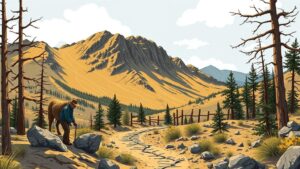Mapping Ancient Lava Beds for Unique Fossil and Mineral Discoveries
Mapping Ancient Lava Beds for Unique Fossil and Mineral Discoveries
Understanding the geological history of Earth provides insights into past environments, climate changes, and the evolution of life. One area of particular interest to researchers is ancient lava beds, which can serve as rich sites for fossil and mineral discoveries. This article delves into the significance of mapping these lava beds and discusses the unique finds that can emerge from them.
The Geology of Lava Beds
Lava beds, primarily formed by volcanic activity, constitute a unique geological feature that can offer a window into the Earths past. processes involved in the formation of these beds typically include the eruption of magma that cools and solidifies, leading to the creation of igneous rock formations. The composition of these rocks often includes various minerals, which can be significant for both geological and paleontological studies.
- Total volcanic eruptions recorded have exceeded 1,500 within the last 10,000 years.
- The mid-ocean ridge system is the longest volcanic chain, stretching over 80,000 kilometers.
Importance of Mapping Ancient Lava Beds
Mapping ancient lava beds yields multiple benefits across various scientific domains, including geology, paleontology, and archaeology. These maps can significantly assist researchers in pinpointing locations of interest for further exploration. For example, the mapping of the Columbia River Basalt Group in the Pacific Northwest has revealed several sites rich in unique mineral deposits and fossils.
The primary methods of mapping these locations often involve geological surveys, where advanced technology, such as Geographic Information Systems (GIS) and remote sensing, play critical roles. By utilizing these modern tools, researchers can create detailed topographical maps that reveal ancient volcanic activity and associated structures.
Unique Fossil Discoveries
One of the most exciting aspects of ancient lava beds is their potential to preserve fossils, which might otherwise decompose or be destroyed in sedimentary environments. Fossils found within volcanic strata often belong to organisms that lived during periods of volcanic activity. For example, in the La Brea Tar Pits of California, fossils from the Pleistocene epoch provide an incredible snapshot of life in that era.
Also, the fossils trapped in lava beds often include not only terrestrial organisms but also marine life buried due to ancient volcanic activity. Research conducted in the volcanic rock layers of the Deccan Traps in India has uncovered significant evidence of past life during the Cretaceous-Paleogene extinction event, where many species, including non-avian dinosaurs, perished.
Mineral Discoveries from Lava Beds
Beyond fossils, ancient lava beds are crucial for mineral discoveries. The solidification of magma often results in the formation of various mineral deposits, including precious metals and gemstones. presence of minerals such as opals and obsidian in lava flows is well documented, with regions like Lassen Volcanic National Park in California showcasing a vibrant array of these resources.
Also, notable mineral deposits within lava beds can contribute to the local economy through mining and tourism. The mineral riches found within the ancient lava beds can offer a means of sustainable development for surrounding communities.
While the mapping of ancient lava beds can yield numerous benefits, there are challenges that researchers must navigate. These include:
- Environmental degradation due to increased visitation and potential fossil poaching.
- The complexities of accurately dating volcanic layers, which can obscure the timeline of fossil preservation.
Also, environmental policies regarding land use must be considered to ensure that these significant geological sites are protected for future research.
Conclusion
Mapping ancient lava beds not only enhances our understanding of geological and climatic conditions in the Earth’s history, but also reveals unique fossil and mineral discoveries that have significant scientific and economic value. Continued research in this field is paramount, as the findings can potentially unravel the complex web of life that existed millions of years ago and provide vital insights into the processes that shaped the planet.
As technology advances, the integration of GIS, remote sensing, and better dating techniques will further facilitate exploration efforts. Ultimately, the quest for discovery within these ancient lava beds remains an exciting frontier in both geology and paleontology, offering promising prospects for future researchers and earth scientists alike.


